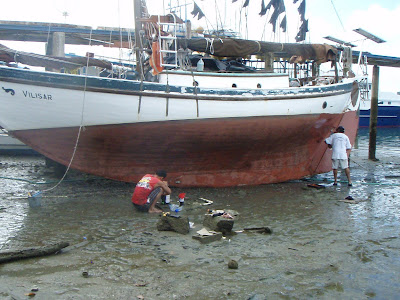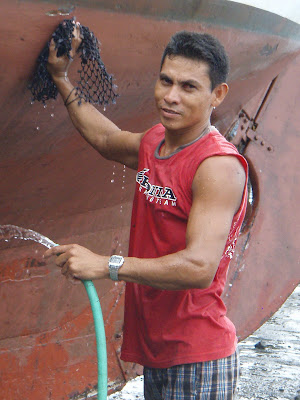Tuesday, March 16, 2010

READY! STEADY! GO?
Golfito, Costa Rica, Saturday, March 13, 2010
Our time in Costa Rica is rapidly running out. Personal tourist visas can be renewed by spending a couple of days just over the border in David, Panamá. There too you can happily mix travelling with shopping at prices that are inexplicably essentially only half of those in Costa Rica. I did just that when Kathleen was returning from Germany via Baltimore, Maryland. Like most cruisers returning from the States or Europe, she had a number of heavy duffel bags full of boat things. Frustrated at the difficulty (thanks I understand to U.S. Homeland Insecurity) of shipping so-called hazmat items like Cetol (synthetic varnish) by sea, I had to cancel two shipments from West Marine and Defender, and find makeshift items instead or make do without. Regard it as money saved, I guess.
It was certainly nice to get off the boat for a while and take the half-day bus ride into Panamá. The wait at the border reminded me of the bad old days in Europe before the customs and immigration stations at the French, German or Dutch borders were removed. Whenever a tour or long-distance bus pulled up to the Panamanian border, the waiting lines got tediously long and cue-jumping became the order of the day. I got Bolshie, and insisted that everybody patiently wait their turn like me. Latinos generally never protest. Instead of letting myself get testy, I should have just gone for breakfast at one of the many ’Sodas’ along the border, or spent an hour turning over the goods at the duty-free shopping malls cum fire traps lining cheek-by-jowl the actual border: enter from the Costa Rican side and exit into Panamá. By the time I arrived at the immigration wicket there were only a few people still behind me in line. Where the rest had disappeared to I have no idea. Maybe they were all dragged into the Panamá Customs shed.

Not only is it good to get away from the boat from time to time, it is beneficial to get away from Golfito too. I have not been adventurous in sightseeing alone in Costa Rica, focussing instead on the boat refit. It definitely seemed a lot drier in Panamá! It is theoretically the ‘dry season’ here (actually I discovered that there is ‘wet season’ and ‘less-wet season’, which of course accounts for it being mainly tropical rain forest around here). It normally rains hard three afternoons a week here; if it does not it is immediately dubbed a ‘drought’. But dry weather is one of the reasons we brought Vilisar here from Panamá. I wanted to strip all the paint off the decks and superstructure down to the bare wood and start again. The main tropical rainy seasons and the intense tropical sunshine have pretty much ruined the many coats of old paint going back to Joe May’s time as skipper. The pictures of Richard of S/V Lilith, Edmonton, AB, indicates one of the daily torrentials we experienced, this time while Vilisar was up on a makeshift grid to have her bottom powdered.
In addition to the boat work I mixed with the multi-culti cruiser crowd. Boats were coming and going: U.S. and Canadian in the majority but Spanish, Dutch, German, Italian, British, etc. etc. as well. Some were coming from the Atlantic and heading for Mexico or British Columbia. Others were killing a little time before striking off across the Pacific to The Marquesas and New Zealand. Once I started to hire locals to help with the major paint-lifting, painting, Cetolling and bottom painting, I became somewhat plugged in to the local community, My Spanish is getting better so I can get along. The Costa Ricans in this little community are friendly and generally willing to accept you; they are by no means the glum fisher folk we encountered in La Cruz, Banderas Bay, Mexico or at La Guardia, Isla de Marquarita, Venezuela. When it comes to money, however, they always recognise a rich gringo. All prices being quoted seem to start at $200 (forget negotiating in Colones!) and drop to $10 or whatever the right amount actually is, always assuming that you even know what the right amount is. I prefer to negotiate down hard and be generous with a tip if the work is good.


Kathleen and I did a bus trip up into the mountains; Costa Rica is very mountainous and earthquake-prone. San Vito is a local market town a mile high and it took us nine hours of bus riding to get there and back. Cruisers need to have buns of steel! It was said to be heavily Italian thanks to immigrants brought out after WWII. But, the only Italian we met, Guido, a waiter in a pizzeria, said that there are now only about 30 or 40 left, the rest having returned to the homeland. It was a good break from the rain and humid heat of the coast, though, and the views from the bus windows were spectacular.
What next? Where next?
Vilisar will have to be moved out of the country by St. Patrick’s Day (17 March). This has to do with customs, since a boat that is here longer than 90 days will be considered to have been imported and 30% customs duties assessed. Kathleen and I have decided to end our cruising career and return to Germany, possibly to Berlin. But, how and where do you sell a sailboat?
I have been conducting a lot of research and talking to brokers in Hamburg, Dartmouth in Devon and in Auckland, New Zealand. The bad news is that the boat market in the U.S.A. and Canada is more or moribund. Repossessed boats are depressing prices and there are acres of yachts on the hard all along the coats. The British broker says the prices for wooden boats are off in England the marina costs there are expensive (though not by the outrageous standards of Central America); Peter Koenig at Baum & Koenig in Hamburg says there is no market at all in Northern Europe at present; it would cost about €6000 p.a. to keep a boat within two hours of Berlin (half the year in the water on a buoy and half on the hard). Both brokers agree that Panamá is no place to try and sell a boat. A Spanish cruising family here confirmed that they have been trying to sell for two years without success here. They are shipping their 30-foot, German-built Hanse-yacht back to Barcelona ($15,000!) by Yacht Transport.
The good news comes from New Zealand. A broker at the largest brokerage in Auckland told me on the phone after looking at our sell-website (www.classicwoodencutter.blogspot.com) that the market is still good in NZ and OZ. Any offshore boat (offshore is the only kind of sailing they do over there) that arrives in good condition in November would be arriving at the best selling season (Christmas to Easter). At the price we are asking, he thinks Vilisar should sell itself and quite rapidly. His word in God’s ear, as the Arabs say.
That more or less confirms that we shall be leaving for the Marquesas tomorrow with a view to being in New Zealand by the end of the year or earlier. Of course we are famous for making vague plans and adhering to them rigorously. You never know! We might just turn right and sail to Mexico! But, at least we checked out today through Immigration, Customs and the Port Captain and our International Zarpe says our port of destination is Nuka Hiva in French Polynesia. We estimate 30-40 days at sea. We have finished filling the water tanks today and loaded up with fresh fruit and vegetables (melons, watermelons, pineapples, apples, bananas, peppers, carrots, potatoes, onions, etc.) and purchased duty-free beer, wine and spirits to last us for several months. We still have lots of tinned food from our provisioning last year when we tried twice to leave for French Polynesia and had to turn back.
We are slightly keyed up to leave tomorrow, but surpassingly much less so than last year. We are getting quite routine at this. Who knows where it will all lead. The weather looks benign and even too quiet for getting as far as the equator. We shall try to sty north of the ITCZ by sailing straight west from here and perhaps getting the benefits of the NE Trades. Then we shall cut across the Doldrums and try to pick up SE trades as soon as we can. They should have set in well by now and then we expect quartering winds at 10-15 knots day and night until we get to Nuke Hiva, nearly 4,000 Nm away from here. Five boats will have left for there this week already, so it is rush hour.
We activated our Iridium satphone so should be able to post about our progress.



















